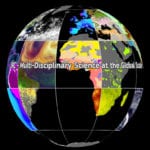Members of the Palaeontological Association gathered in Leeds, United Kingdom, for an annual reunion. With talks and posters to satisfy every palaeo-taste, it was a meeting to remember.
Palaeontological Association Annual Meeting: An Insider’s Perspective
Members of the Palaeontological Association gathered in Leeds, United Kingdom, for an annual reunion. With talks and posters to satisfy every palaeo-taste, it was a meeting to remember.
Collaborative WorkBench for Researchers – Work Smarter, not Harder
There is a need to augment scientists’ computational research environment and tool set to allow them to easily collaborate with each other.
Collaborative Workbench provides a solution by integrating the researcher’s desktop with a cloud infrastructure enabling not only the sharing of research artifacts but also the collaborative development of algorithms and interpretation of data and analysis results.
The Global High Frequency Radar Network
By Dr. Hugh Roarty Research Project Manager Coastal Ocean Observation Laboratory Rutgers University Co-authors: Ms. Lisa Hazard, Dr. Lucy Wyatt, Dr. Jack Harlan and Mr. Enrique Alvarez Fanjul The Global High Frequency Radar Network is a vision for a global operational system measuring ocean surface currents to support monitoring of marine and coastal ecosystems. The measurement of ocean currents is … Read More
Weaving the Narrative of Climate Change: The Process Behind the IPCC 5th Assessment Report
The 5th Assessment Report from the International Panel on Climate Change represents an example of broad scientific collaboration. In an interview with Earthzine, Lead Author Chris Field discusses the challenges and benefits of this international enterprise and why he feels that science has the capacity to address the challenges posed by the potential impacts of climate change.
The Future of Earth Observation – GEO-X
At the Group on Earth Observations’ 10th Plenary and Ministerial Summit in Switzerland, Jan. 12-17, delegates from 90 countries and 77 international organizations charted a course for a second decade of “unleashing the power of open data to improve the quality of life for people everywhere.” Earthzine science writer Osha Gray Davidson was there, providing live coverage of this historic event.
Application of Next-Generation Satellite Data to a High-Resolution, Real-Time Land Surface Model
![Figure showing Difference plots (LIS minus control) of a 13-hour forecast valid at 1600 UTC, June 9, 2008, for the following fields: a) sensible heat flux (W m-2), b), 2-m dew point temperature (in degree Celsius), c) PBL height (m), and d) CAPE (J kg-1). Adapted from [5]. Figure showing Difference plots (LIS minus control) of a 13-hour forecast valid at 1600 UTC, June 9, 2008, for the following fields: a) sensible heat flux (W m-2), b), 2-m dew point temperature (in degree Celsius), c) PBL height (m), and d) CAPE (J kg-1). Adapted from [5].](https://ieeeearthzine.wpenginepowered.com/wp-content/uploads/2013/04/Diff-in-CNTL-150x150.jpg) A suite of real-time soil characteristic products for the contiguous United States will be enhanced by data from the upcoming Soil Moisture Active Passive (SMAP) and Global Precipitation Measurement (GPM) satellite missions. These products are used by operational weather forecasters to aid in analyzing and forecasting drought, extreme heat, and convective initiation.
A suite of real-time soil characteristic products for the contiguous United States will be enhanced by data from the upcoming Soil Moisture Active Passive (SMAP) and Global Precipitation Measurement (GPM) satellite missions. These products are used by operational weather forecasters to aid in analyzing and forecasting drought, extreme heat, and convective initiation.
Fostering Environmental Awareness from a Young Age: A Case Study from the IGES Art Contest
 The Institute for Global Environmental Strategies’ annual art contest serves as a prime example of integrating art and science in the classroom. Students benefit from the practice of visually sharing what they know. Instructors are able to tailor their lessons based on the artistic renderings of students.
The Institute for Global Environmental Strategies’ annual art contest serves as a prime example of integrating art and science in the classroom. Students benefit from the practice of visually sharing what they know. Instructors are able to tailor their lessons based on the artistic renderings of students.









